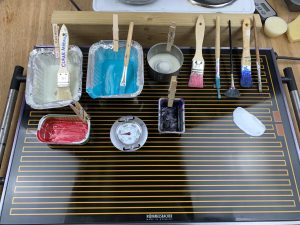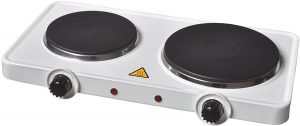Let’s talk Hotplates!
I thought I would write a blog on Hotplates, and heat sources, it’s one of the most common questions I get asked, and if I’d known at the beginning, what I know now, I could have saved myself a small fortune!
I’ve bought so many different types of heat sources; every trip to town in the early days, would see me wandering around a hardware store eyeing up different sources for melting my waxes.
Budget was an issue at the time, and I was looking for the cheapest, easiest way to get started that I could find.
Unfortunately, I metaphorically kissed a few frogs before I found some solutions that worked for me!
Some were way too hot, and would have the wax smoking in a few minutes (don’t do that, it’s really not good for your health) others just didn’t get the wax hot enough, you’d get a small smear of wax, but it was nowhere near hot enough to maintain the melting point.
I found a particularly swanky looking second hand, table top hostess trolley, designed for keeping food warm, I thought I’d hit the jackpot, it really looked the business, but totally under performed in terms of keeping my wax moving, that one went off to the recycling depot. (Don’t use containers for food again after they’ve been used for wax.) Nice try Julie, but no cigar!
Various other ingenious methods followed, but few with really lasting, workable results.
I could have saved myself a lot of time, and money in the long run with a bit of advice, but that was pretty few and far between in the UK, at the time I started painting with wax.
So, based upon my experiences, these are my recommendations, and what I’ve found to work for me in the UK. These exact models may not be available in different countries, but just knowing some names to look for, and the key temperature ranges might just save you some time and money.
Some of these links go through to Amazon, as an associate, I earn from qualifying purchases.
Teppanyaki Grill. Price £20-£50

This is a great, low cost option, the thermostat does cut in and out quite a bit, so make sure you have a surface mounted thermometer to check temperature, and stay vigilant with it to make sure it’s not too hot. My brand is a VonShef, but there are other manufacturers, they’re also available in a choice of sizes, so search around and get the a size that works in your space. The long VonShef version is here.
A2 Ultimate Hotplate. Price £295

A higher price point, but well worth the investment in my view. As one lady on a workshop called it… “The Rolls Royce of Hotplates!” This model has a very constant steady thermostat, so little need to keep adjusting the thermostat during a session. Ensure your tins have a flat base, to get maximum heat conduction. It has a large surface area, great for working directly on the hotplate.
Generally, I’ve only needed to adjust the temperature according to the heat in my studio. The difference is noticeable between using it during the summer, and winter, I needed it on the maximum setting to work when the studio was really cold, and it was harder to keep tins of wax molten in the winter, but it still works well.
If you live in a particularly cold country, or work during the winter months a lot, you may want to do some more homework around this. I’m happy to share my experiences in more depth, feel free to contact me.
I’ve had quite a few people from the States ask me where they can source this product from.
I’ve contacted my supplier, who advised me that there is a transformer, but it’s preferable to use a hotplate with the correct voltage in your own country. This alternative was recommended by them, but please do your own homework. I can’t vouch for this!

For heating large amounts of wax for working on large scale pieces, I use this model, using the small simmering side only. The hotter side gets way too hot, even on the lowest setting. (I believe there is a small single version, but again, I can’t personally vouch for it.) I melt a large saucepan of encaustic medium, or colour, it’s hot enough to keep larger quantities of wax in a fluid state, and I can check the temperature with a food thermometer. (Don’t forget, never use for food, after you’ve used them for wax.) I then use this in conjunction with the hotplates mentioned above to mix additional colours.
I’ve found these three models to work in the UK, and a with system that works for me.
I know there are many other heat sources out there, so do your homework and find a solution that works for you, but do keep these key things in mind…
The waxes used in encaustic painting, generally have a working temperature of 180 – 200’F / 82 – 93’C, so you’ll need to ensure the heat source you choose a) reaches those temperatures, and b) has a minimum temperature within that range. If not, your wax will either not melt, or be smoking and letting off fumes, which is not safe for your health, and could potentially reach a flash point. (I’ve never reached that stage thankfully!)
Some products tell you the heat range, others don’t, if they don’t, at least look for a wide range of temperature options.
Consider the thermostatic controls… You know how you hear the thermostat click on and off on the heating, or your iron at home, when the temperature drops below a certain point? That’s what I’ve found tends to happen with some of the more budget options, which will mean you’ll be adjusting your thermostat regularly to keep the wax fluid, but not overheat it. The art specific heat sources tend to be at a higher price point, but in my experience, it’s because they are designed to have a slow, steady thermostat, which doesn’t cut in and out constantly.
The lower grade thermostats, generally mean more observation, and adjustment will be required on your part.
Both will work, but it’s a consideration you might want to be aware of…
If you want to do some more research, here is a YouTube video I made, showing these products in more detail, and explaining exactly how I started out…
If you’ve found this information useful, and want to go deeper with encaustic, check out my online courses here: https://artyheaven.com/online-courses/ I teach artists and creatives how to paint with expressive, unusual mediums, so they can make unique works of art, that stand out from the crowd, reflecting their own individual personality. Choose from individual single courses, or my better value course bundles… Ascertain the foundations… then make them your own…! View here.




Thanks for your suggestion. As soon as our lockdown will be partially abolished, I will look for one of those Sabbath plates.
You’re welcome, pleased you’ve found it helpful… Do sign up to my newsletter if you’ve found it useful. I don’t bombard you with information, but have lots of resources that can help, all sent direct to your inbox. Or, follow on social medias, so you don’t miss other updates. Best of luck. 🙂